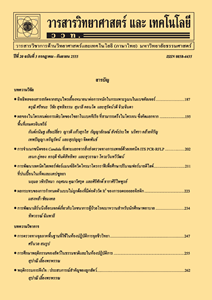การบำบัดน้ำมันหล่อลื่นที่ใช้แล้วด้วยกรดอะซิติกพร้อมกับการดูดซับโลหะหนักด้วยถ่านกัมมันต์จากผักตบชวา
Main Article Content
Abstract
Abstract
In this research, the treatment of used lubricating oil by acetic acid and heavy metals adsorption with activated carbon from water hyacinth have been studied. The response surface methodology (RSM) based on Central Composite Design (CCD) was used to investigate the effects of two parameters, such as the amounts of acetic acid and the reaction temperature, on the acid sludge removal. The regression quadratic equation has been presented to show the relation between the percentage of acid sludge removal and two parameters. The results revealed that the reaction temperature is the important parameter. The optimum conditions were: 11.2 %v acetic acid and the reaction temperature of 45 °C with the reaction time of 60 min. The acid sludge removal under the optimized conditions was 15.30 %. In addition, the adsorption of heavy metals in acid treated oils has been compared. It was found that adsorption with activated carbon from water hyacinth can reduce the amount of heavy metals rather than that of adsorption with activated clay. The content of lead, iron and zinc remained at 11.25, 0.34 and 366 ppm, respectively.
Keywords: used lubricating oil; acetic acid; activated carbon from water hyacinth; acid sludge removal; response surface methodology
Article Details
References
[2] Udonne, J.D. and Bakare, O.A., 2013, Recycling of used lubricating oils using three sample of acids and clay as a method of treatment, Int. Arch. App. Sci. Technol. 4(2): 8-14.
[3] Udonne, J.D., 2011, A comparative study of recycling of used lubricating oils using distillation, acid and activated charcoal with clay methods, J. Petroleum Gas Eng. 2(2): 12-19.
[4] Eman, A. and Abeer, M., 2011, Re-refining of used lube oil, II- by solvent/clay and acid/clay-percolation processes, ARPN J. Sci. Technol. 2: 1034-1041.
[5] Shri, K.C., Mohan, K.K.S., Sakeer, H.M., Deepa, P.N. and Saravanan, K., 2014, Studies on reuse of re-refined used automotive lubricating oil, Res. J. Eng. Sci., 3(6): 8-14.
[6] Isah, A.G., Abdulkadir, M., Onifade, K.R., Musa, U., Garba, M.U., Bawa, A.A. and Sani, Y., 2013, Regeneration of used engine oil, Proceeding of the World Congress on Engineering, London.
[7] 911Metallurgist Mineral Processing Engineers, Acid Activated Clay Adsorption Properties, Available Source: https://www.911metallurgist.com/acid-activated-clays, December 8, 2016.
[8] ASTM International, ASTM D 2270-93 (Reapproved 1998), Available Source: http://www.asiajuleh.com/astm/ASTM%20D%202270.pdf, November 29, 2016.
[9] Owrang, F., Mattsson, H., Olsson, J. and Pedersen, J., 2004, Investigation of oxidation of a mineral and a synthetic engine oil, Thermochimica Acta 413: 241-248.
[10] Díaz, R.M., Bernardo, M.I., Fernández, A.M. and Folgueras, M.B., 1996, Prediction of the Viscosity of Lubricating oil Blends at any Temperature, Fuel 75:


